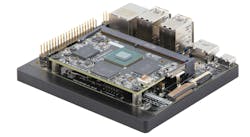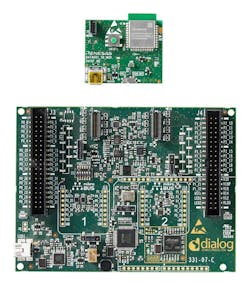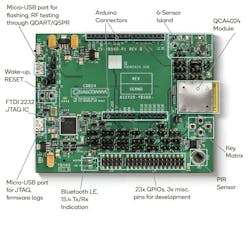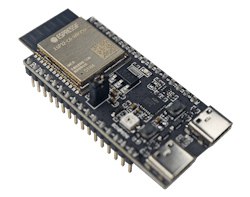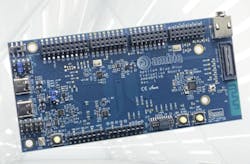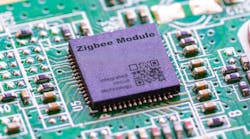The Latest Wireless IoT Dev Kits to Close Out 2025 (Part 1)
What you'll learn:
- Which wireless IoT kits are designed for advanced multiprotocol and Matter-ready projects?
- How today’s boards integrate debugging, sensors, and AI into a single platform.
- Why newer dev kits are pushing low-power, multi-radio design into industrial and consumer IoT ecosystems.
Wireless connectivity has moved well past the usual hobby boards and into next-gen development kits built for industrial IoT, AI-enabled devices, and connected infrastructure. From multiprotocol RF platforms and LoRaWAN gateways to systems-on-chips (SoCs) that pack Wi-Fi 6, Bluetooth Low Energy (BLE) 5.4, and Thread into a single platform, today’s wireless IoT kits provide engineers and developers with the flexibility to design and deploy connected systems.
This roundup looks at the latest wireless IoT development kits that go beyond the typical Arduino and Raspberry Pi hardware. For more dev kits, see Part 2 of this series.
Synaptics Astra Machina SL2610 Dev Kit
The Astra Machina SL2610 Development Kit is aimed at developers seeking a next-gen platform for rapid prototyping and multimodal AI-native IoT applications. Synaptics’ platform offers an SL2610 SoC with a single- or dual-core Arm Cortex-A55 CPU, an Arm Cortex-M52 with Helium System Manager, an I/O base board, daughtercards for integrated Wi-Fi and Bluetooth connectivity, debug, and programmable I/O.
According to Synaptics, target applications include home appliances and automation, consumer goods, industrial control systems, smart retail, charging infrastructure, healthcare diagnostics systems, casual gaming, and robotics and UAVs.
Renesas DA1469x Development Kit
Designed around Renesas’ SmartBond DA1469x SoC, the SmartBond DA1469x Development Kit provides developers with increased processing power for applications such as high-end fitness trackers, advanced smart-home devices, and virtual reality game controllers. The SoC integrates a BLE 5.2 MCU and a configurable MAC, allowing manufacturers to deploy the 2.4-GHz and Bluetooth Low Energy 5.2 protocols.
The board includes on-board power measurement, a SEGGER debug probe, and a set of expansion connectors for sensor interfaces. The DA1469x Development Kit also comes with the company’s DA14695MOD Multi-Core BLUETOOTH 5.2 Module, which integrates all passives, including an antenna, and 32-Mb QSPI flash. The SDK includes reference apps for BLE ranging, voice command, and sensor hub integration.
Qualcomm QCA4024 Development Kit
Qualcomm’s QCA4024 Product Development Kit is designed to create unique IoT products that work in tandem with myriad other devices. It’s well-suited for developing IoT applications such as smart cities, toys, home control and automation, appliances, networking, and home entertainment. The QCA4024 dual-mode SoC module that populates the board integrates Bluetooth 5 and 802.15.4 for wireless applications, an on-board FTDI2232 IC for 4-wire JTAG debugging, an Arduino header to equip shields, and an array of sensors.
u-blox EVK-NORA-W10
The u-blox EVK-NORA-W10 Evaluation Kit is based on the NORA-W10 multi-radio (Wi-Fi and Bluetooth) modules. It can serve as a reference design for the NORA-W10 series multi-radio modules, enabling faster hardware development and shorter time-to-market.
The evaluation board is equipped with Arduino sockets to add different shields for any number of different projects, including IoT, telematics, low-power sensors, connected buildings, point-of-sales, health devices, AI, and facial recognition.
The board also integrates a dual-core 32-bit MCU based on the Espressif ESP32-S3 chipset, which incorporates Wi-Fi 4 (802.11b/g/n) and Bluetooth Low Energy v5.0. Thanks to the open CPU architecture, users can run their applications directly on the module without a host MCU, reducing development time.
Espressif ESP32-C6-DevKitC-1
The ESP32-C6-DevKitC-1 is a low-power SoC built around a 32-bit RISC-V core and designed for IoT applications. Espressif’s kit integrates 2.4-GHz Wi-Fi 6 (802.11ax), Bluetooth 5 (LE), IEEE 802.15.4, and support for Thread and Zigbee protocols. It packs both a high-performance core (up to 160 MHz) and a low-power core (up to 20 MHz), alongside 320-kB ROM and 512-kB SRAM.
The platform also supports connectivity features such as OFDMA, MU-MIMO, and Target Wake Time (TWT) to improve efficiency and battery life, even in congested wireless environments. Furthermore, the ESP32-C6-DevKitC-1 enables Matter-compliant smart-home devices by combining Wi-Fi, Bluetooth, and 802.15.4 radios into a single package.
Ambiq Apollo4 Blue EVB
Ambiq’s Apollo4 Blue EVB is an ultra-low-power SoC designed around the company’s proprietary SPOT (Subthreshold Power-Optimized Technology) platform. It’s designed to function as both an application processor and a co-processor in battery-powered edge devices such as smartwatches, fitness trackers, voice remotes, animal trackers, and smart-home sensors.
The board is built around an AMA4BKP-KXR SoC with an Arm Cortex-M4, integrated Bluetooth Low Energy 5.4, and HexSPI interface for faster access to PSRAM or other external memory.
Kits Mirror the Strides Made in IoT Tech
The wireless development ecosystem has evolved into platforms defined by versatility and efficiency. Whether it’s Texas Instruments’ multiprotocol SimpleLink platform, Espressif’s RISC-V-based Wi-Fi 6 boards, or Ambiq’s power-optimized Apollo4 systems, each kit represents a different corner of IoT innovation.
The kits show how far integrated wireless systems have come, and how much flexibility is now available to engineers to build smarter, faster, and more efficient connected designs. Stay tuned for Part 2 for more wireless development kits.
>>Check out the wireless IoT dev kits in Part 2
About the Author
Cabe Atwell
Technology Editor, Electronic Design
Cabe is a Technology Editor for Electronic Design.
Engineer, Machinist, Maker, Writer. A graduate Electrical Engineer actively plying his expertise in the industry and at his company, Gunhead. When not designing/building, he creates a steady torrent of projects and content in the media world. Many of his projects and articles are online at element14 & SolidSmack, industry-focused work at EETimes & EDN, and offbeat articles at Make Magazine. Currently, you can find him hosting webinars and contributing to Electronic Design and Machine Design.
Cabe is an electrical engineer, design consultant and author with 25 years’ experience. His most recent book is “Essential 555 IC: Design, Configure, and Create Clever Circuits”
Cabe writes the Engineering on Friday blog on Electronic Design.

